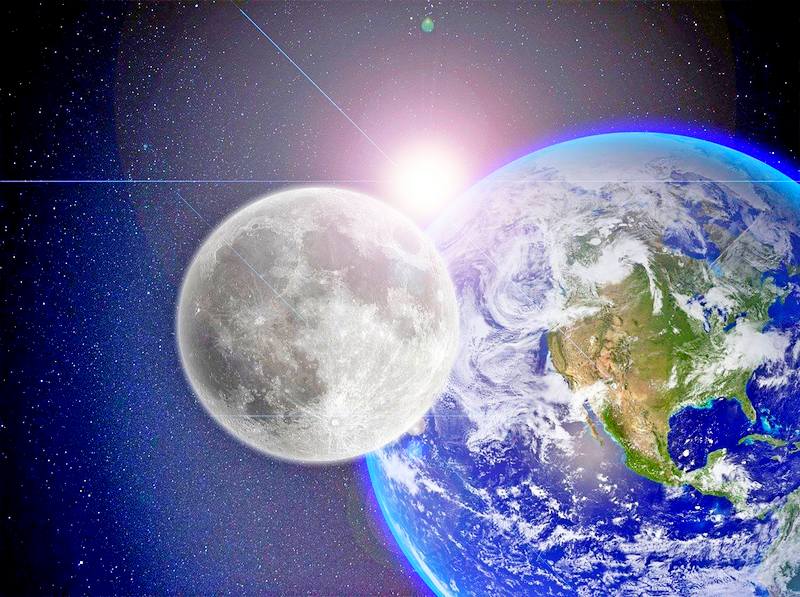A Lifetime of Planetary Cycles by Opeaus Blair

By Jack Heart - January 8, 2023
A New Year is upon us, and with it comes new ‘cycles’, a seemingly unending revolution that drives everything (hu)man knows, everything we do, everything we are, revolving in a great ‘spiral’ since time immemorial. It is the great churning wheel(s) of the ‘cosmos’; the spinning gods within our solar system, on a spiraling journey through ‘Time’, with its mirror within each of us.
Stories of (hu)man’s existence, passed down to us through myriad tales from antiquity, always speak of (hu)men seeking guidance by looking up to the stars in order to gain some understanding and attribute ‘meaning’ to their lives. Nowhere is this more apparent than in the hermetic phrase – “As above, So below”.
Linguistically speaking, these words were originally sourced from the ‘Emerald Tablets of Thoth’ and are an important alchemical ‘maxim’ and astrological philosophy (‘observation’). They refer to a correspondence of the different planes of existence (physical and non-physical, what is often referred to as spiritual), and the relationship between the ‘macro-cosmos’ – the Universe (or for the purposes of this story today, our solar system), and the ‘micro-cosmos’ – (hu)man as the universe of an ‘Individual’ (manifested here on ‘Earth’). Understanding of this brings to mind another phrase that you may have heard before – “The Ages of Man”.
In literary works, these words were introduced to the ‘consciousness’ of (hu)man (at least the earliest written example), by Claudius Ptolemy in his 2nd Century work entitled: ‘Tetrabiblos’. This phrase ‘summarises’ how the ages of the ‘individual’ are characterized by the ‘planets’. In essence (according to the words of Ptolemy – espoused by many others since), each of the spheres of the seven planets (Uranus, Neptune, and Pluto were yet to be ‘discovered’), rule a number of set years from the birth till death of a (hu)man. To paraphrase Ptolemy:
Firstly, the Moon was said to rule the ‘pliable’ infant and toddler (ages 0-3), Mercury then takes over and rules the ‘flexible’ mind of the young school child (ages 4-13), before passing to Venus who rules the ‘passionate’ pubescent young adult (14-21). The Sun then rules the prime of ‘life’ (22-40), with Mars taking rulership of the crisis of passing one’s ‘prime’ (41-55). Jupiter then rules the ‘wise’ years of renunciation, rest, and reward (56-67), followed lastly by Saturn ruling the declining years of bodily ‘breakdown’ (68-death).
Earnest readers will recognize this accounting of life in the words of William Shakespeare, within his comedy play: ‘As You Like It’ (Act II, Scene VII), wherein the division of (hu)man’s ‘life-cycle’ are placed into seven stages through the: “All the world’s a stage…” monologue. It is thanks to Ptolemy, that we have much of Modern Astrology, but these simple (although relevant ‘observations’) obscure a much more ‘enlightening’ accounting.
Observation of the revolutions, ‘correspondence’ and cycles between the planets (macro-cosmos) and the cycle of consistency, ‘growth’, and succession within the life of (hu)man (micro-cosmos) is more beautiful and intricate than the ‘structure’ expounded by Ptolemy and Shakespeare.
These phrases (“As above, So below” and “The Ages of Man”), along with the ‘philosophy’ that underpins them, provide the inquisitive mind with a fresh light to ‘shine’ on the planet's relationship with (hu)man’s endeavors, development, and ‘purpose’ (through life). Many have walked this ‘path’ before, as we shall see in the telling of the tale. One such was the ‘renowned’ occultist, alchemist, and physician known as Paracelsus, who wrote some five centuries ago:
“To understand correctly the meaning of the worlds alchemy and astrology, it is necessary to understand and realize the intimate relationship and the identity of the Microcosm and Macrocosm and their mutual interaction. All the powers of the universe are potentially contained in man and man’s physical body, and all his organs are nothing else but products and representatives of the power of Nature…
If I have “manna” in my constitution, I can attract “manna” from heaven. “Saturn” is not only in the sky but also deep in the earth and in the ocean. What is “Venus” but the “Artemisia” that grows in your garden? What is “iron” but “Mars”? That is to say, Venus and Artemisia are both products of the same essence, and Mars and iron are both manifestations of the same cause.
What is the human body but a constellation of the same powers that formed the stars in the sky? He who knows what iron is knows the attributes of Mars. He who knows Mars knows the qualities of iron. What would become of your heart if there were no Sun in the Universe? What would be the use of your “vasa spermatic” if there were no Venus?”
Inferred by Paracelsus’ words is the eternal truth that (hu)man is, at this manifest level, an ‘organized’ system of activities, just as the solar system is, and that these two systems exist in a “harmonic” relationship with one another – As above, So below…, therefore becomes more than just a maxim, it becomes our reality. So, let’s commence with the planet we are all most familiar with – ‘Earth’.
It is only from our vantage point on Earth that observation(s) (and thus knowledge and understanding) can be made, and it is the microcosmos of (hu)man’s ‘existence’ within Earth where our tale inevitably starts. Once thought to be the center of the universe, it is from our planet that we are able to ‘perceive’ the other planets, and thus their rotational cycles around the Sun (and Earth).
Morning’s dawn today (as the Sun rose above the horizon here on Earth), heralded a new ‘birth’, a new life, within the 365-day ‘solar’ cycle marking (hu)man’s solar year. The Sun has always been considered by astrology (and alchemy), as the most important of the planets, it is the Sun that is the representation of the life of (hu)man ‘himself’. The Sun is the axle of our cosmic wheel, and it is currently considered the primary force in our cosmic system (at least that is the case as we view our Sun ‘today’ from the vantage point of Earth).
Essentially, it is the spiraling, spinning journey of our Earth around the Sun that provides (hu)man’s lifecycle with days and nights, the seasons, and the years. The Sun is said to represent (hu)man’s ‘Ego’, ruling the heart and spine (as well as being the ‘blood’ of (hu)man), and it is symbolically represented as a circle with a dot in the center – the circle symbolizing the soul (or spirit in some cases), and the dot representing the divine spark (the ‘I’).
The Sun, therefore, astrologically personifies the ‘eternal’ self, you that has no beginning or end, you as boundless and infinite, you as the very core of your being, the Sun is the ‘essence’ of who we are, the essence that carries over/through from one life to the next. The basis of (hu)man as promulgated by Rudolf Steiner:
“Ego and Sun are the inner and the outer aspects of the same being. What orbits out there through space as the sun is the cosmic I. What lives within me is the human I.”
Our Sun and Moon are Earth’s celestial ‘duality’ that provide the succession of day and night, with each ruling over part of each ‘cycle’, they encapsulate the male/female ‘duality’, rising and setting in place of each other as ‘Time’ (perceived on Earth). Moon represents the subliminal realm of the ‘subconscious’ (unconscious), contrasting with the light of the solar ‘conscious’ mind.
The Moon is the Mother, whilst the Sun is the Father of (hu)man. The Sun provides the spark, whilst the Moon is the receptive/passive ‘reflection’ of the experience of life; our emotions, instinctual reactions/feelings, and ultimately, our most basic/essential needs and survival instincts. If the Sun is the Ego of (hu)man, then the Moon is (hu)man’s ‘Memory’.
From the Moon, we observe the passage of the ‘months’. In a tale about cycles, the Moon has the fastest of all, taking 27 and a half days to transit through all twelve Zodiac signs, during which time it has a profound impact on our emotions and decisions. As well as planetary revolutions around the sun, we should also focus on what is termed – ‘Returns’. The solar return occurs once every 365 days. The Sun's return (on our birthday) produces a ‘recharge’ of our life (soul) purpose and (its placement within the Zodiac) suggests the kind of events that lie ahead over the next year of our lives.
A lunar return occurs on average 13 times a year, they should be considered our monthly birthdays (if only we had 13 calendar months), and just as with the Sun, the Moon return shows/unveils each of our ‘emotional’ states during that month, along with how we might respond (emotionally) to upcoming events. (Hu)man is therefore deeply connected to the Moon, and in addition to marking the months, it also has it's own ‘progressed’ lunation cycle operating within (hu)man. In the words of Dane Rudhyar:
“These cycles and their most characteristic phases (New Moon, First Quarter, Full Moon, Last Quarter, and Balsamic Moon), when properly analyzed and evaluated, help us to know what time it is on the clock of our inner life. Within such a frame of reference, the positions of the “progressed planets” find their most meaningful places. But this clock of our inner life is very different from the physical clocks we are used to, and which are attuned to the rhythm of the earth’s rotation around its axis and, in more complicated clocks, also to the rhythm of the seasons and the apparent yearly path of the Sun along the zodiac.
It does not strike inevitable hours. It does not refer to inevitable events. Let me stress here that the planets’ transits in the sky day after day, year after year are not to be confused with the progressions. The former deal with objective time, and the latter with subjective time. The transits of Uranus over a particular degree of Virgo affect every human being born with the Sun to that degree; they are indisputable “facts of life.” But a person’s response to these facts depends primarily on his natal chart (the blueprints of his individual nature) and secondarily on his progressions — i.e., on the subjective time it is in his inner life.”
Progressed lunation cycles occur every 27-28 years (and last for three and a half years, hence the common perception that such occur at the age of 30), and it is at this age, that a crucial emotional ‘change’ occurs in (hu)man. It is usually at this stage in our ‘lifecycle’ that we have (an often uncomfortable/unfortunate) encounter with our destiny/fate. It is of no coincidence that so many famous musicians and actors depart our manifest world at this point in their lifecycles.
This progressed lunation cycle, occurring at the age of 27/28, again at 54/55, and then at 81/82, marks the beginning(s) of new ‘instinctual’ cycle(s) (the Moon rules the reproductive organs, and therefore these are also the stages when the female biological clock chimes. The first chime is if no child has been born by then, with the second chime marking the last chance warning before the closing down of the reproductive function, as for the last – this is beyond ‘comprehension’).
The progressed Sun and Moon perform a dance every 30 years or so, the timing of such is ‘dependent’ upon our personal birth charts (the most essential tool for our understanding of ‘self’).

Jack Heart
Jack Heart, the pen name for George Esposito, is known for his extensive research and writings that provide high-quality information and authentic alternatives to mainstream narratives on a wide variety of subjects. His life experiences make for a highly intriguing perspective
The Earth has always been controlled by the Universal force of the Chaos Theory, which is influenced by The Domino Effect, which can create a future catastrophe through human intervention.

